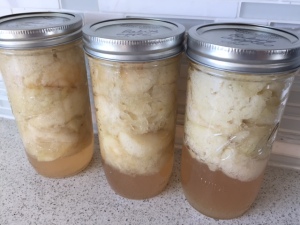Last year’s bumper crop of apples has led to this year’s apple dearth – there just aren’t that many apples around this year. And here I was all ready for the season too, having purchased an apple picker this past spring and all ready to go “professional”!
Last year, Wild Wise Sooke was posting furiously to see who could pick pears and apples from trees around Sooke so that we didn’t attract the bears into town. My daughter and I picked both kinds of fruit several times – at one location stepping over lots of bear scat – and canned pear and applesauce alone and with two friends on separate occasions to try to keep up with it all. We are still using up some applesauce, actually, from last year’s supply.
This year, not so much. Wild Wise Sooke hasn’t been contacted much by people who have lots of fruit because it’s just not a bumper crop kind of year. A quick search of the Facebook group Sooke Social came up with – thankfully – one person outside of town who had an abundance of apples to sell cheap, and so we dropped by there a couple of weeks ago with the new picker in hand. What she had were lovely, very large, Bramley apples (a variety I had to look up; they’re tart baking apples) and we went away with four cloth shopping bags full after picking for just half an hour. (My daughter loved that she got to climb the tree.)
However, picking apples is one thing…making them into something preserved is another. It takes work! So far I’ve made one batch of canned applesauce, one apple crisp, and one batch of canned baking apples. I’ve also given away one bag of apples to a canning friend. My daughter declared the applesauce the best she’s ever eaten so I’ll be doing 2-3 more batches of that to use up my apple stock and to last us throughout the year. I used this Bernardin applesauce recipe, the Spiced Applesauce variation. There is no hard part about it, it mostly just takes time to wash and prepare the jars, peel, core and cut up the apples, cook the sauce and wait for the 20 minute processing time in the water bath canner.
The baking apples (recipe from the Ball Blue Book) were another story. It was partly user error as I didn’t read the recipe quite properly and had to redo one step, but overall these took a lot of time for not much yield. And, as you can see in the picture, I got a bad case of fruit float (even though they looked full when I was filling them) and half the jar ended up as syrup. I’ve never canned apples for baking before so I probably did something wrong, but overall it didn’t seem worth the effort so I don’t think I’ll be doing those again.
Applesauce actually saves quite well in the freezer so I might try to save a little processing time and put one batch into medium freezer bags and stow them away in our standup freezer. Just like with any kind of canning, applesauce does take time but I love having it on hand for packing school lunches throughout the year. And it is SO much better than the grocery store-bought option. I’ll just have to put my apple picker into more active use next year!
















